Knife Fighting.
Set of must-know knife fighting technics
Few words about your motivation. In a modern "visual" culture, an average American sees 40,000 murders by the time he/she turns eighteen - on screen, of course. This is not a figure of speech, some statistically declined folks counted it and published results. Forty thousand. Which does NOT prepare you to fight to death. Sorry. Bad news. Same with this textbook or knife fighting classes, for that matter. Fighting for real is different, and you are advised to stay avay from it, if you can. Seriously.
More bad news: using knife in a fight is a crime, not an act of heroism. A 2 inches blade used against five attackers will make YOU an aggressor in the eyes of almost any jury. Think about it. Think about it twice.
Also, knife is dangerous, as it is very hard to control. In karate, you need to apply significant force to make a permanent damage. You don't need to be physically strong AT ALL if you use knife. An advice? Learn to run, and if you can not run, make sure you know NLP to talk your way out of a conflict.
When they say that fighting is a desperate thing, it means - the last thing you do when everything else failed.
Ok, this was your fair warning.
How to use this book? Well, as was already mentioned, it presents you with a set of exercises, each focusing on a particular technic, exploring its aspects, possible variations and defenses. Follow instructions, that's all.
You will need a partner. I doubt that it is possible to learn any martial art without one, but in a knife fight the distance and timing are so important that a partner is an absolute must. Also, if you can get more than one partner, get them: every opponent have different speed, different length of a step, and different "body clues" you are supposed to react to. Getting used to a single partner is a bad idea.
You (and your partner) will need a knife. You can buy a rubber one, but I advise you against it. The blade of a real knife is solid, and you use it to deflect attacks. While with the rubber blade you will not be able to do a good half of technics.
You can use "tanto", a wooden knife used in aikido, but it traditionally has a pointy tip which you will have to make round, otherwise your partner will have bruises and if you accidentally hit him in a face, it can get really messy. Also, a wooden knife feels differently, which may or may not be important.
An ideal knife should be made of a rigid plastic, like polyethylene, be 3-5 mm thick and have a round (as opposed to pointy) tip. If you want to make it yourself, buy a plastic food board and cut the knife from it. Make sure to remove any splinters.
So far I said nothing about the shape of a knife and its size. Well... The size is important, the larger the knife, the better. But you cannot guarantee that you will have your favorite machete handy when you need it, so make sure you can work with knives of different sizes. The difference is dramatic.
As for the shape, go for a straight blade sharpened on one side. Of course, it is just an agreement, you are not supposed to sharpen the knife you use to work with your partner, but you need to always keep in mind which side of a blade is sharp.
On the following image, the first knife is absolutely NOT suitable as it has a pointy tip, the second knife is ok, and the third knife... do you really believe that you will have something like that when you need it? So you choose the second one, it is safe, has a universal "no extras" shape and even is slightly asymmetrical, so you always know which side is "sharp".
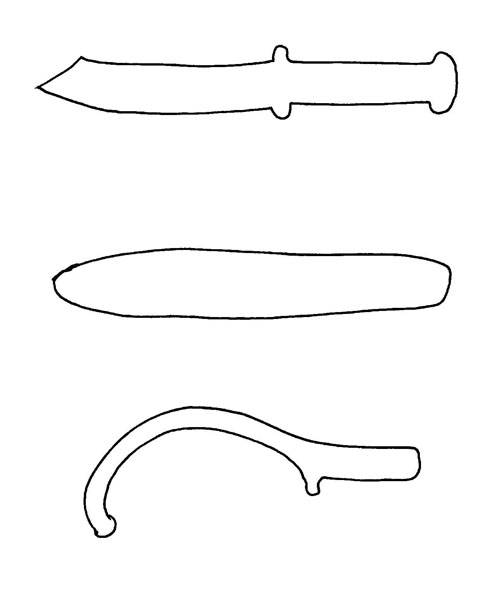
You will need some protective gear. First of all, a glove. A rigid plastic knife can damage your fingers, so either buy a special glove or use a hockey one.
You will need a protector for the forearm. It is possible to work without it, but it hurts and therefore distracts you, preventing from focusing on technic. If you do not want to buy a protector, use elastic bondage, it does the same job or even better.
Finally, a vital part of your equipment: eye glasses. Either purchase a specialized version, or go to a construction market for a cheap one. Never practice with partner without eye glasses, as it is a sure way to loose an eye.

Tactics and distances
What knife (and any weapon, for that mater) does is making your attacks more dangerous. This is something people usually are aware of but not to its full extend. Human body can stop a fist, but it can not stop - or even slow down - the blade. As the result, one can cause significant damage by barely touching the opponent - with the knife.
And (see the article Fighting a stronger opponent for some details on how minor changes in your abilities and objectives affect your fighting style) it changes your technics dramatically. First of all, in hand to hand combat we don't care about opponent touching us with the tip of his finger. Karate uses ma-ae term to describe a distance from which you can attack, and if you are further than that - you have to make a step forward. Have to, simply because even if you bend forward and touch your opponent, there will be no power in such an attack.
Unless you have a knife. A simple touch, one that would be powerless in a bare hands fight, can cut opponent's skin, possibly damaging arteries. And even if not - will you be able to hold a knife if your hand is damaged?
As the result, knife fight uses a concept of distance, that is slightly more complex: you have three distances instead of two. First is the safe distance. Neither you nor your opponent (provided you have hands of comparable length, which is not necessarily so) can reach each other. Not even with the tip of a blade. Unless you bend or step forward, which takes time and your opponent will use it to prepare.
I think it is a good time to talk about the response time, which is the time you need to react to an attack. I am going to quote my own Fighting a stronger opponent article, as it covers the topic well.
Let's play a game. It looks simple, but I knew people making their living out of it. So... you got a dollar bill? OK, I hold it like that, and you put your hand right below.

At a random moment, I am going to release the dollar bill, and you should catch it by bringing your fingers together. Just fingers, you are not allowed to move your hand down. Ready?
Sorry, you've just lost.
Let me explain. As Earth's gravity is a constant, the dollar bill will move between your fingers and down with a certain speed, accelerating. And it will take it a certain time. Say, 1/4 of a second.
As for your reaction, it takes the image to be received in your eyes' retina, then transformed into an electrochemical signal, to be sent to your neocortex, processed and recognized as "dollar is moving". Then a signal has to be sent to your hand, and it takes some extra time for it to reach your fingers. Plus time for your muscles to move your fingers.
And that is GUARANTEED to take more time than takes a dollar to fly through. See the problem here? You are GUARANTEED to loose. It is not about your martial arts training. Not about your reaction. No. It is a set-up.
Got another dollar?
This is an important lesson: there are events you can not react to. In time, I mean. It is PHYSICALLY impossible.
One of Bruce Lee's videos captured an amazing demo. He was attacking his opponent, a martial artist, not a guy from the street, with a side kick to the head. The slowest kick, and an opponent KNEW what Bruce was about to do.
Yet he wasn't able to deflect it, one time after another.
If you punch as fast as you can, your opponent will not be able to intercept it. Period. Same if your opponent punches. This is why they jump around in boxing, three meters from each other, this is a safe distance! And when your opponent moves forward, you see it and have some extra time to respond (in boxing - by jumping back or bending or whatever).
A safe distance is a concept, not a number in inches. You can bend forward. Your opponent can extend a hand forward, so you suddenly can reach it without doing a step. You (or him) can move the body weight forward (or back) and so on. But as long as you cannot attack in ONE motion, it is a safe distance.
When you move closer to the opponent, you enter the distance of reach. You can reach him, he can reach you. Again, you can bend forward, so the distance is limited by a zone, not by the line.
Finally, there is a "desperation" zone, the distance allowing you to attack opponent's body. Whoever makes a first mistake, dies, and as both of you move fast, the best fighter at this distance is not necessarily the lucky one. That's why it is called "desperation".
Fighting at a distance of desperation is good when you are much better than your opponent. Or when he does not expect your attack. In a movie, when a good guy takes down a guard, he goes for the body; wouldn't it be stupid to approach an enemy from behind just to cut his hand?
When your fighting skills are comparable to skills of your opponent, fighting at a close distance is called a "Mexican duel", a pseudo-humorous situation resulting in two dead bodies having twenty knife wounds each.
To avoid it, you use "control", either (very rare) grasping the opponent's armed hand or simply pushing it away. You will study controls later in this book. If the control is mutual, knife fight looks a lot like wrestling till the first mistake someone makes.
In addition to the new terminology, this little chapter gives you an important clue on what to do if someone you don't trust COMPLETELY has a knife (or has his hand in a pocket or behind his back). Keep the safe distance. He moves forward - you should move back, with your hands extended out towards your opponent (yes, you look stupid, so what?). If he attacks, he'll attack your hands instead of your neck, and (as the distance is still safe) you will have a chance to either go back or to do something with his (now exposed) knife, for example, you can establish a control (see later in this book) and punch him in a face (works well even if you don't have a knife).
Also, as people often attack boldly, trying to get to a distance of desperation, you will have to learn to go sideways, kind of like on a corrida. See, if someone runs at you with the knife, you cannot stop him, and the moment he is at a desperation distance, it is a fifty-fifty situation. But what is you step to the side, allowing him to keep running forward, as the faster he runs, the harder it is for him to change the direction? Of course, you will also use your knife while moving off his way...
In addition to fighting at a desperation distance, you can fight at between the safe distance and the distance of reach. Imagine your opponent entering the distance of reach, cutting your hand and moving back. Few times. Well... That's it. You lose blood, he circles around, preventing you from using the bandage to stop the bleeding, and then you collapse.
To summarize, you are going to learn to keep the distance that is convenient for you, to give the opponent surface cuts whenever you can, and to control his weapon when you enter the distance of desperation. Sounds simple, doesn't it?
The reverse knife grasp.
We will only scratch the surface so to speak. Using the reverse knife grasp is as popular and as dangerous as using a traditional way of holding it.
Your opponent enters the distance of reach and attacks you by stabbing along the central line down. Block that attack with your left hand and attack by the tip of your knife to either a forearm or biceps of your opponent.
Note that this approach is very popular in knife technics: you have an opponent's hand in front of you - you stab it. Why risking by going forward to attack his body?

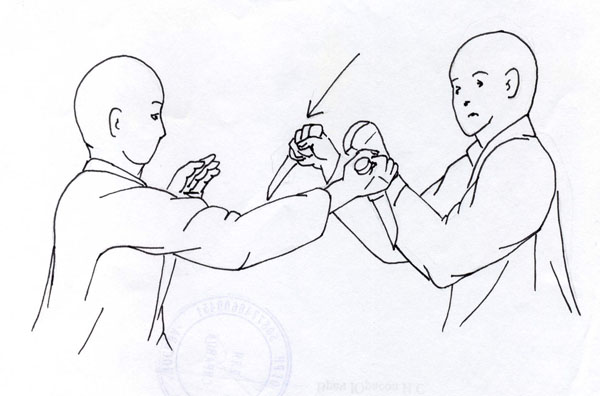
As always, you need to move from one technic to another in a smooth flow-like way. In a particular case, both block and a counter attack should feel like a whole, not like two separate moves.
Let's take a look at a variation of this technic, this time your opponent stabs you from inside, his knife moves from his left shoulder towards your neck either horizontally, or at 45 degrees down.
As before, you can stop an attack with your palm and then, as opponent's hand is still to the left from the central line, you can attack its exposed part.

The same approach works when your opponent attacks your lower section, just keep in mind that he can punch you in the face with his left hand while you are busy with his right one. Ignoring such threats is a common mistake done by beginners, especially if they studied knife fight in its "pure" form. The real fight is dirty.
A generalized version of the technic described above: this time you perform blocking with your armed hand as it is usually closer to an opponent. Then you place your left hand at opponent's arm, releasing your right hand for a counter attack.


Sometimes you make mistakes. For example, when blocking an attack with the blade you can miss and accidentally use the very tip of a knife. The knife in this case works as a leverage and you will not be able to hold opponent's hand.
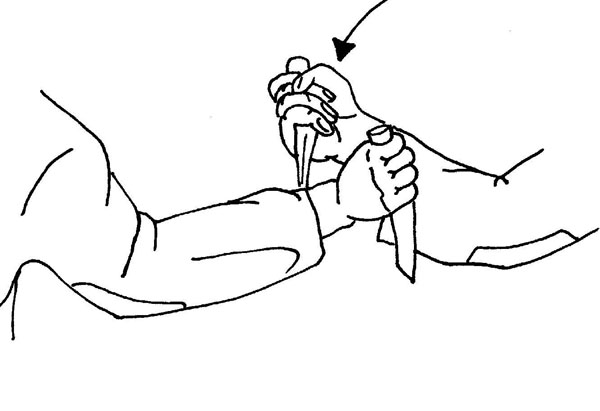
If it happens, you can roll your hand around opponent's hand, so that the blade now uses the "strong" (from the point of view of the length of a leverage) part of it to press against opponent's hand. During that rolling, the (in this example) inner block (you push opponent's hand to the left) will become the outer one (now you push his hand to the right).

Same sequence again, notice the defending party moving outside, turning opponent the other way. As the result, you rolled your hand to use the strong part of a blade and moved the point of contact closer to opponent's elbow. It is best to control his elbow, as it limits his options it terms of counter attacking you with fist elbow or shoulder.


As for knife, at the end of that technic it rests on your forearm, which makes it even stronger.
Same idea, but this time an opponent attacks from the opposite side. If you miss, the knife touches (cuts) the forearm of an opponent with its very tip. On the image below you can see a proper safety measure: your left hand moves forward the moment you feel something is wrong, to hold back opponent's elbow.

Next thing you do is moving opponent's hand off the way, do it in a wide high amplitude arch to open your opponent completely:

###
When you hold your knife in a reversed way and your hand gets into contact with opponent's hand, you can use your knife as a "hook" to affect opponent's hand (if you hold a knife in a traditional way, you can use the base of your thumb to do the same).

If you use unarmed hand, you can create a similar hook by bending the palm towards the baby finger (picture below).
After the second attack (and a second block) you may end up in a situation when both hands are "hooked". Taichi technics (http://taichi.snowcron.com) work well here. Also remember that you (and your opponent) can use kicks and a good old hit in the face with the head works well too (so do not bend forward in this situation).

By the way, another possible scenario is when one of hooks is mine and another is done by my opponent. As in Tai Chi, the moment you get control over a point of contact, you can attack. On the following picture, an attacker used a hook to pull opponent's hand in, and used it to launch a strike. He turned an arm when doing it, aiming for the armpit.

Note: in a situation described above, you can attack not only the body, but also a shoulder or forearm, when possible, you can strike few times in a row (so called "sewing machine").
Let's examine the image above. An attacker pushed opponent's wrist down with the wrist of his armed hand while holding it in place with the "hook". His elbow moves up. Therefore (more details in a Tai Chi textbook) you are now at opponent's "In" side and therefore you can attack. Note that a direct pressure down can be done with sufficient force, as you have your fist right on top of opponent's wrist.
During the following attack, the elbow moves to the right and up, so the stabbing can be done from below into the armpit (one you opened by pressig at opponent's wrist).
###
In this exercise you and your partner will exchange attacks each consisting of two strikes with the knife or (at random) a feint and a strike.
A defending party blocks the first attack, blocks the second attack with either the same or with another hand, pushes the attacker's armed hand off the central line and counter attacks aiming at the body or the neck.
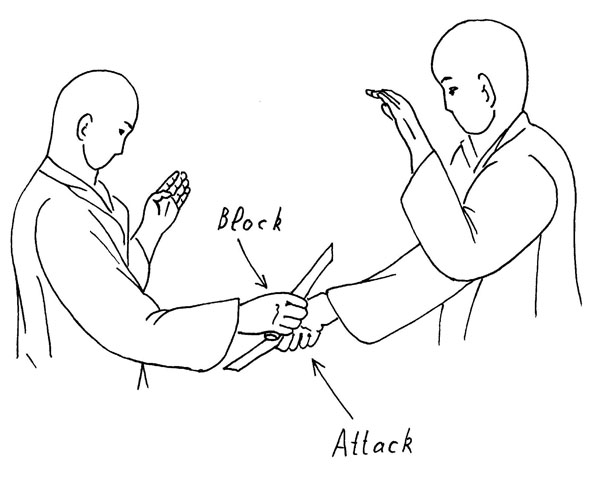


When practicing, try changing hands (both attacker and defending party), so that you do not become predictable. Otherwise neither you nor your opponent will be able to improve the technic.
As was mentioned above, a feint begins as the first (of two) attack, but you switch to the second one without completing the first. The idea is to trick an opponent into committing his attention to one direction while switching fast to the other.

Few words about optimal attacks. When attacking, every time try to do it the way which is most inconvenient for your opponent to block. Also, keep in mind that it should also be inconvenient for him to counter attack. One of the ways of doing it is to move to the side, so that after his (or your if you are attacking) attack you are at the outer side of an attacker hand. This way he is controlled by you through that hand (and the leverage is large, see the picture) while his other hand cannot reach you at all.
Opponent attacks. You move forward and to the side:


###
In this exercise, a defending partner blocks the first attack of his opponent. The moment their hands touch each other, you have what is called (in Tai Chi) a "point of contact".
Attacker's objective is to launch the second attack, using the point of contact as a support, pushing against it and moving around it - and forward.
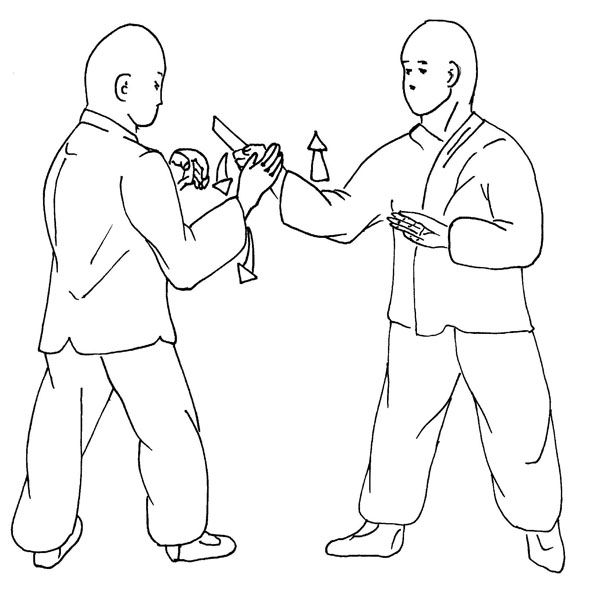
Note that when you do the technique, you will be tempted to move your hand back at the point of contact. Don't. You have to only go forward, breaking the contact at the contact point for the final strike.
Note also, that there can be many possible attacks from a "contact" position, not just a straight one:


When you practice, to make your partner's life easier, begin with a fast attack, but slow down when a point of contact is established. Sometimes, especially at the beginning, figuring out what to do next can be confusing.
Advanced
In this exercise you are going to leave aside "fencing" an to focus on the tactical things. When your opponent runs at you ignoring possible damage to his hands, launching one strike after another, it is literally impossible to stop him. Also, as he runs forward while you have to run backwards, it is impossible to break the distance by going back (we assume you are going to fight for some reasons, but please, always consider turning around and running away).
The only approach that works is to go sideways, the faster he runs the harder it is for him to turn, so you have a good chance of entering his weak zone.
Two important points. First, keep the distance. It means that you should stay outside the zone of desperation, or one of his strikes will succeed sooner or later. See, the problem here is in the initiative, which he originally has and if he attacks boldly ignoring your counter attacks, it is a game of a chance.
In the same time, if you are good in a distance game, and he runs boldly at you, you may WANT him to continue, until you slide to his side. So another objective is to not scare him away.
Part of your tactics will be to retreat as long as you can, attacking from the distance of reach, and to go sideways first chance you get. Under no circumstances should you allow an opponent running at you to enter the distance of desperation (unless you are moving to his side already). It is like you are inviting him "come on, come on", and then - boom! - you are not there. It should be absolutely unexpected for your opponent.

When practicing this exercise, the person attacking tries to run forward fast enough, so that the defending party can not outrun him when going backwards.
By the way, according to criminal statistics, this is the most dangerous attack of all.
As for an attacker, when practicing the exercise, he has to make sure he is NOT taken by surprise when an opponent suddenly slides to the side. It means that, regarding the fact that you can not stop abruptly (you were running after all), you should try to follow an opponent by turning your body, unless you run away from the zone of reach:
Let me explain the paragraph above. Say, you are running forward launching strikes: one, two, three... Naturally, they go in the direction your opponent is, which is in front of you. Now your opponent stepped to the side: where your next strike should be directed and where should you look (and your torso has to be turned)? Straight, where no one is now, or to the side, where your opponent now is? Yes, you cannot stop, but at least, you can look at your opponent, trying to catch his counter attack.
